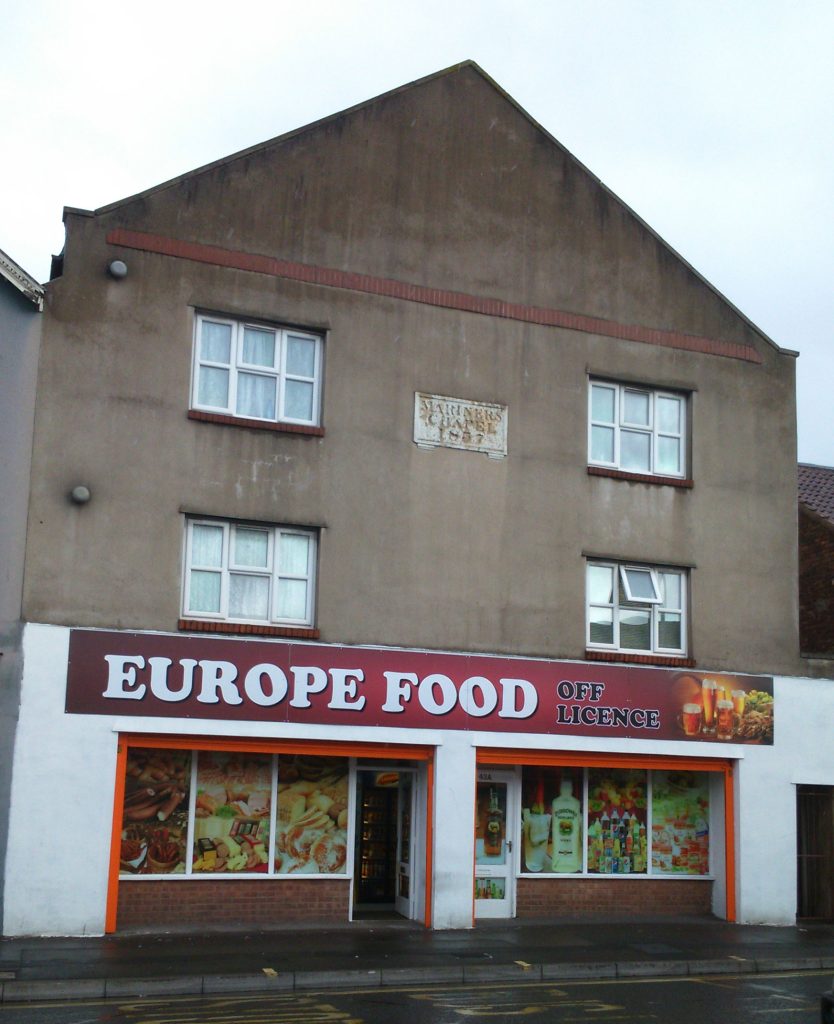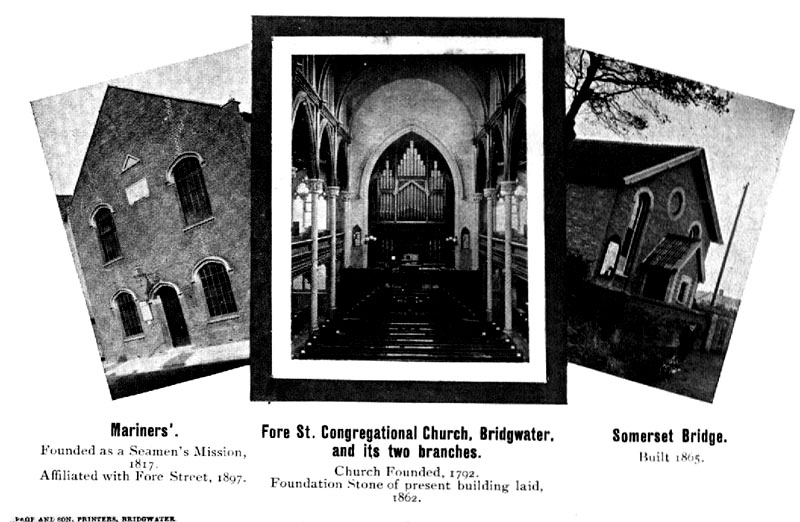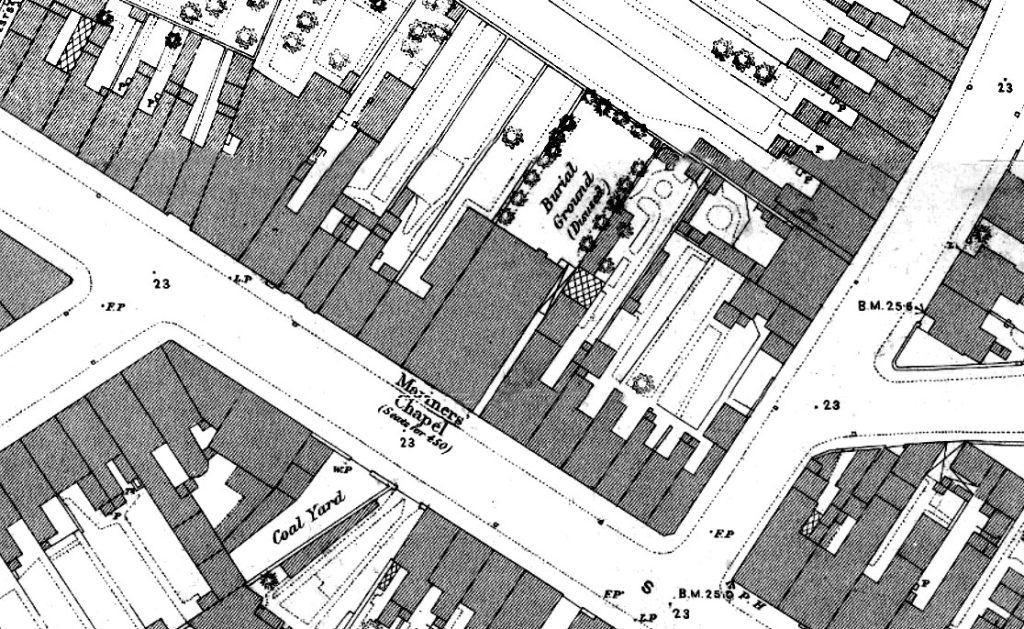The Mariners Chapel in St John Street was built in 1837 and closed in 1960.

The Mariners congregation started as a nonconformist (i.e. not Church of England) mission for seamen, and originated around 1817 (Dunning, Victoria County History). This effort was broadly Methodist in approach.
An Indenture of 24 November 1838 was made between William Peach of Bridgwater, a Twine Manufacturer and the newly-formed trustees of this congregation. They included:
- William Henry Holmes of Bridgwater linen draper
- Samuel Stephens of Spaxton linen draper
- Richard Thomas grocer
- Joseph Francis plumber and glasier
- William Preece Carpenter
- Samuel Hodge yeoman
- Thomas Preece carpenter
- Edward West accountant
- William Norris saddler
- George Berry book-keeper
- John Bovett of Combwich malster
This indenture concerned
‘all that plot of land being part of a certain close called Saint John Close containing in front adjoining a new Road or Street called John Street there intended to be and since set out and made by the said leasers from the Turnpike Road at Eastover and running therefrom in a southerly direction by the Eastward End of Barclay Street, forty feet of thereabout and in depth backwards from there one hundred and forty feet… which lies on the north eastward side of the street and is bounded on the north westward by a plot of land granted to Abraham Squibbs and on the south eastward by a plot of land then lately granted to William Knight.’
William Peach had acquired the property via indenture of 1 August 1837 (from Samuel Capper, Young Sturge, James Ireland Wright, John Hurford, William Gandry, Arthur Thomas Tanner, John Naish and John Brevran – they were presumably nothing to do with the chapel and just the prior landowners). Since then Peach had erected a chapel on part of the property which had hence been used ‘by the congregation a society of dissenters of the denomination called the Mariners Christian Society’. This chapel he sells to the trustees for £404 16s. (Somerset Heritage Centre D/N/bmc./C/2897/2/1/5)
William Peach’s obituary mentioned how he was a paper manufacturer in partnership with Mr Wansborough of Bristol at the paper mills of St Decuman’s Watchet. He was a committed Methodist and contributed to all of their congregations in Bridgwater. The Mariners chapel was built entirely at his expense. He is buried in a family vault in Huntspill Church (Western Daily Press 23 March 1867)
The ‘Mariners Christian Society’, mentioned above folded in 1857. Thereafter the chapel continued more or less independently, theological somewhere between the Congregationalists, the Methodists and the United Methodists. The building was renovated in 1876 and reopened at the end of October that year, Rev J. Lawrence was recorded as pastor at the time (Western Daily Press 2 November 1876).
The first minister from 1838 was a Rev James Samuel Duck and he served for some 33 years. In 1871 he fell ill and was unable to fulfil many of his duties. The committee of the chapel therefore appointed Rev. John Lawrence. However, on 3 October that year, during Lawrence’s ‘recognition service’, Duck, his wife Lucy Duck, daughter Emma Lillycrap, Charles Cubb, Mary Cubb and John Winn disrupted the service, shouting and jumping onto the seats in opposition. Trouble had been expected as two policemen had been asked to attend, such was the strength of opposition. Lawrence had to take the Duck party to the borough petty sessions, although the case was dismissed. Duck did not recover his position though. (Langport & Somerton Herald 21 October 1871). John Lawrence served until 1879 (Jarman).
In the 1880s more formal links with the Congregationalists were established. Apparently from about 1883 to 1898 the congregation was only between 3 to 12 people, despite being capable of holding 450. An effort was made to transfer the chapel to the Congregationalists under Rev. E.J. Dukes in 1883, although this effort failed due to opposition among certain trustees who were either Baptist or Anglican. More headway was made in 1886, but things were left unresolved until 1896 when Dukes took charge. The building was renovated and Rev. C.G. Box was appointed minister and the building reopened in 1898 (Nonconformist 03 February 1898 – also see Jarman). It is therefore unsurprising that no registers for the congregation survive prior to 1900.

Kelly’s Directory of 1927 mentions how a schoolroom had been added in 1911 (Somerset Heritage Centre, notes of Roger Thorne).
Behind the chapel was a small burial ground, presumably in use from after 1837 (as it is not mentioned in the indenture of that year). This was closed by Act of Council in 1854 (Somerset Heritage Centre D/N/ch/2/4/1). No burial register survives for this burial ground, so it is a mystery as to who is buried there. Presumably the burials are still there under the later car park.

The chapel was sold in 1960. Since the departure of Rev. T. Watkins in 1957 the chapel had had no minister, and the congregation had apparently dwindled as much of the nearby housing had been demolished for the new relief road. A new church was planned for the Sydenham estate, where many of the displaced around St John Street were being rehomed. Two covenants existed on the property, which restricted the sale, one being that it could not be used as a brewery, second that it should not be used as a Roman Catholic chapel (Taunton Courier and Western Advertiser 12 December 1959)
A transcription of funerals listed in D/N/bw.msb/3/3/3 ‘Mariners Congregational Chapel Bridgwater List of Baptisms Marriages and Funerals from 1900’ can be found in the members’ section of the website of the Friends of the Wembdon Road Cemetery.
MKP 7 May 2023
